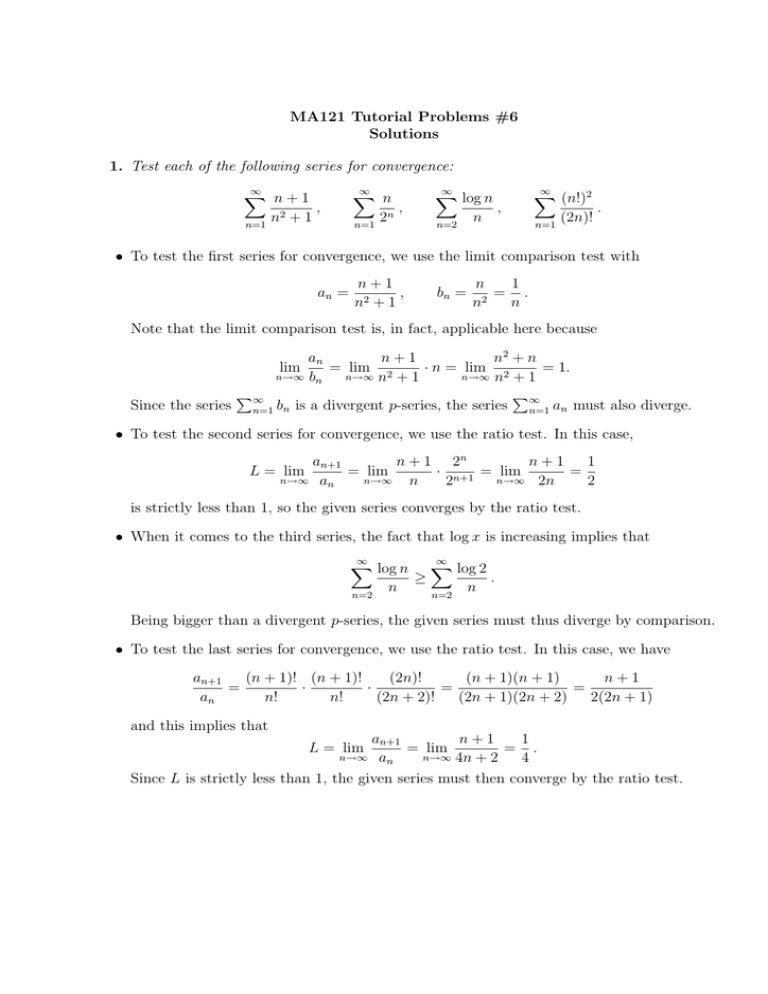MA121 Tutorial Problems #6 Solutions X
advertisement

MA121 Tutorial Problems #6 Solutions 1. Test each of the following series for convergence: ∞ X n+1 , 2+1 n n=1 ∞ X n , n 2 n=1 ∞ X log n n=2 n , ∞ X (n!)2 . (2n)! n=1 • To test the first series for convergence, we use the limit comparison test with an = n+1 , n2 + 1 bn = n 1 = . n2 n Note that the limit comparison test is, in fact, applicable here because an n+1 n2 + n = lim 2 · n = lim 2 = 1. n→∞ bn n→∞ n + 1 n→∞ n + 1 P P∞ Since the series ∞ n=1 bn is a divergent p-series, the series n=1 an must also diverge. lim • To test the second series for convergence, we use the ratio test. In this case, an+1 n + 1 2n n+1 1 = lim · n+1 = lim = n→∞ an n→∞ n→∞ 2n n 2 2 L = lim is strictly less than 1, so the given series converges by the ratio test. • When it comes to the third series, the fact that log x is increasing implies that ∞ X log n n=2 n ≥ ∞ X log 2 n=2 n . Being bigger than a divergent p-series, the given series must thus diverge by comparison. • To test the last series for convergence, we use the ratio test. In this case, we have an+1 (n + 1)! (n + 1)! (2n)! (n + 1)(n + 1) n+1 = · · = = an n! n! (2n + 2)! (2n + 1)(2n + 2) 2(2n + 1) and this implies that an+1 n+1 1 = lim = . n→∞ an n→∞ 4n + 2 4 Since L is strictly less than 1, the given series must then converge by the ratio test. L = lim 2. Test each of the following series for convergence: ∞ µ X n=1 1 1+ n ¶n , ∞ X n+2 , n3 + 1 n=1 ∞ X n! , nn n=1 ∞ X µ 1 log 1 + n n=1 ¶ . • The first series diverges because of the nth term test, namely because µ ¶n 1 lim an = lim 1 + = e 6= 0. n→∞ n→∞ n • To test the second series for convergence, we use the limit comparison test with an = n+2 , n3 + 1 bn = n 1 = 2. 3 n n Note that the limit comparison test is, in fact, applicable here because an n+2 n3 + 2n2 = lim 3 · n2 = lim = 1. n→∞ bn n→∞ n + 1 n→∞ n3 + 1 P P∞ Since the series ∞ n=1 bn is a convergent p-series, the series n=1 an must also converge. lim • To test the third series for convergence, we use the ratio test. In this case, we have µ ¶n n an+1 (n + 1)! nn nn = · = = an n! (n + 1)n+1 (n + 1)n n+1 and this implies that an+1 L = lim = lim n→∞ an n→∞ µ n n+1 ¶n = 1 . e Since e > 1, this limit is strictly less than 1 and the given series converges. • To test the last series for convergence, we use the limit comparison test with µ ¶ 1 1 an = log 1 + , bn = . n n Note that the limit comparison test is, in fact, applicable here because µ ¶ µ ¶n 1 an 1 = lim n log 1 + = log e = 1. lim = lim log 1 + n→∞ n→∞ bn n→∞ n n P∞ P Since the series ∞ n=1 an must also diverge. n=1 bn is a divergent p-series, the series 3. Compute each of the following sums: ∞ X 3n+2 , 22n+1 n=0 ∞ X 5n+1 n=1 23n . • When it comes to the first sum, the formula for a geometric series gives ∞ ∞ X 3n+2 9 X 3n 9 1 9 = · = · = · 4 = 18. 2n+1 n 2 2 n=0 4 2 1 − 3/4 2 n=0 • When it comes to the second sum, a similar computation gives ∞ X 5n+1 n=1 23n =5· ¸ 1 5 25 =5· −1 =5· = . n 8 1 − 5/8 3 3 ∞ X 5n n=1 ·






